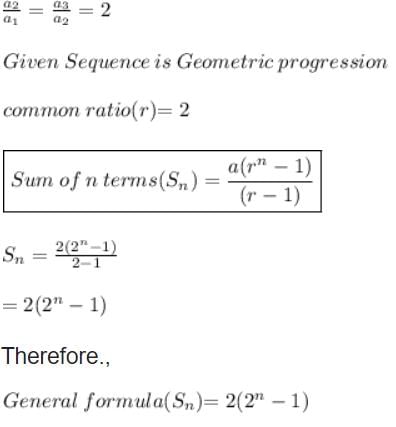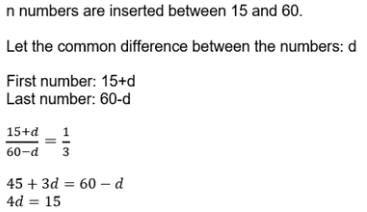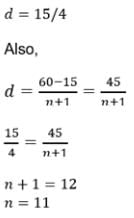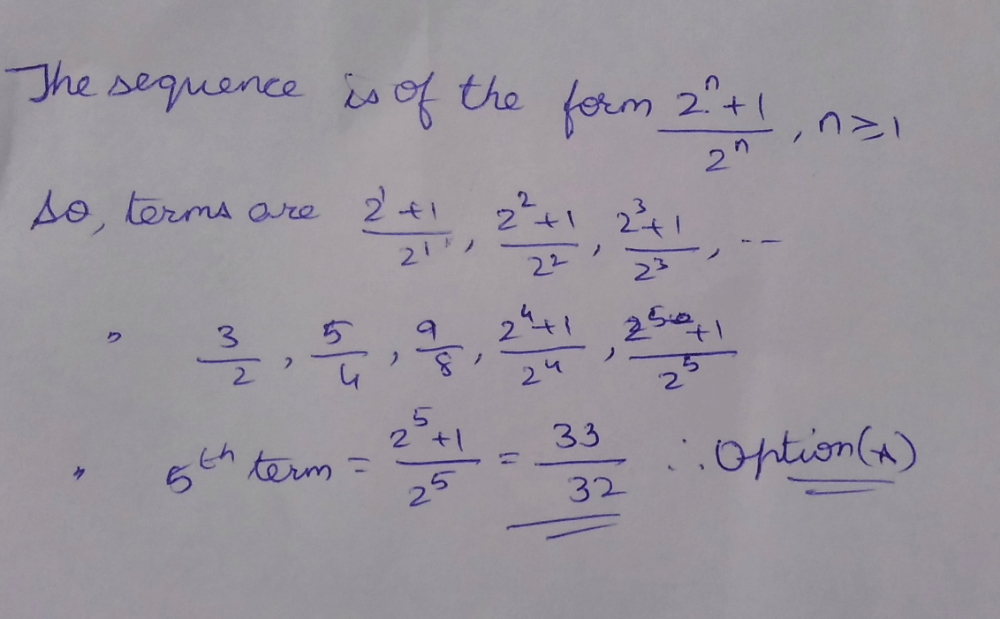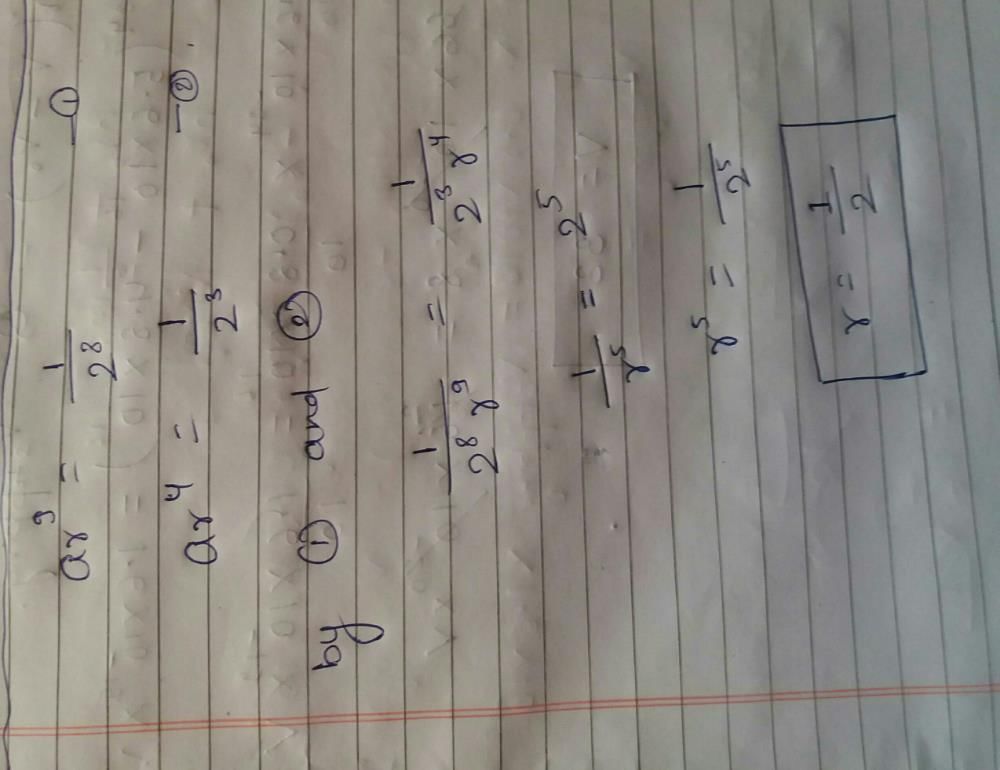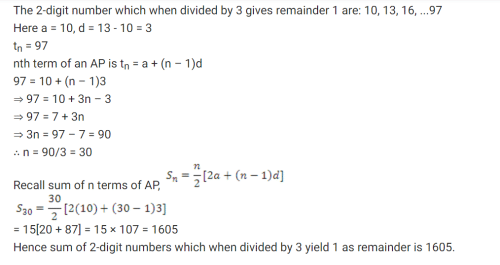All Exams >
Commerce >
Online MCQ Tests for Commerce >
All Questions
All questions of Sequence and Series for Commerce Exam
What is the 50th term of the sequence √3, 3, 3√3, 9, ......- a)(√3)49
- b)(√3)50
- c)349
- d)350
Correct answer is option 'B'. Can you explain this answer?
What is the 50th term of the sequence √3, 3, 3√3, 9, ......
a)
(√3)49
b)
(√3)50
c)
349
d)
350
|
|
Nandini Iyer answered |
an = ar(n-1)
Given, a = √3, r = 3/√3
r = √3
a50 = ar(n-1)
= (√3)(√3)(50-1)
= (√3)(√3)49
= (√3)50
Given, a = √3, r = 3/√3
r = √3
a50 = ar(n-1)
= (√3)(√3)(50-1)
= (√3)(√3)49
= (√3)50
Find the missing number. 1, 4, 9, 16, 25, 36, 49, (....)- a)64
- b)54
- c)56
- d)81
Correct answer is option 'A'. Can you explain this answer?
Find the missing number. 1, 4, 9, 16, 25, 36, 49, (....)
a)
64
b)
54
c)
56
d)
81
|
|
Anjana Sharma answered |
The given number series as follow as 1^2, 2^2, 3^2, 4^2, 5^2, 6^2, 7^2, 8^2, ...
So the next number is 8^2 = 64.
The terms of an A.P. are doubled, then the resulting sequence is- a)An A.P. with common difference equal to the common difference of the original A.P
- b)An A.P. with common difference thrice the common difference of the original A.P.
- c)An A.P. with common difference double the common difference of the original A.P.
- d)An A.P. with common difference half the common difference of the original A.P.
Correct answer is option 'C'. Can you explain this answer?
The terms of an A.P. are doubled, then the resulting sequence is
a)
An A.P. with common difference equal to the common difference of the original A.P
b)
An A.P. with common difference thrice the common difference of the original A.P.
c)
An A.P. with common difference double the common difference of the original A.P.
d)
An A.P. with common difference half the common difference of the original A.P.
|
|
Lavanya Menon answered |
The general form of an AP is a, a+d, a+2d,.....
where a is the first term and d is the common difference
If we double the terms, the new sequence would be
A , a+2d, a+4d,......
We can observe that this sequence is also an AP
First term is a
Common difference is 2d nth term= 2a+(n-1)2d
= 2[a+(n-1)d]
where a is the first term and d is the common difference
If we double the terms, the new sequence would be
A , a+2d, a+4d,......
We can observe that this sequence is also an AP
First term is a
Common difference is 2d nth term= 2a+(n-1)2d
= 2[a+(n-1)d]
The next term of the sequence 1, 2, 4, 7,11,…. Is- a)18
- b)17
- c)16
- d)15
Correct answer is option 'C'. Can you explain this answer?
The next term of the sequence 1, 2, 4, 7,11,…. Is
a)
18
b)
17
c)
16
d)
15

|
Imk Pathsala answered |
The given series is: 1,2,4,7,11,...
Difference between second and first term = 2 - 1 = 1
Difference between third and second term = 4 - 2 = 2
Difference between fourth and third term = 7 - 4 = 3
Difference between fifth and fourth term = 11 - 7 = 4
Difference between sixth and fifth term = 16 - 11 = 5
Difference between second and first term = 2 - 1 = 1
Difference between third and second term = 4 - 2 = 2
Difference between fourth and third term = 7 - 4 = 3
Difference between fifth and fourth term = 11 - 7 = 4
Difference between sixth and fifth term = 16 - 11 = 5
The sum of the first hundred even natural numbers divisible by 5 is- a)55005
- b)55000
- c)50000
- d)50500
Correct answer is option 'D'. Can you explain this answer?
The sum of the first hundred even natural numbers divisible by 5 is
a)
55005
b)
55000
c)
50000
d)
50500
|
|
Preeti Iyer answered |
first even no. divisible by 5= 10
d=10
Sn = n/2(2a + (n-1) d)
S100= 100/2 (2(10) + (100-1)10)
S100=50(20 + 990)
S100= 50(1010)
S100 = 50500
The first negative term of the A.P.62,57,52…. is the- a)10th term
- b)14th term
- c)12th term
- d)18th term
Correct answer is option 'B'. Can you explain this answer?
The first negative term of the A.P.62,57,52…. is the
a)
10th term
b)
14th term
c)
12th term
d)
18th term
|
|
Naina Sharma answered |
a = 62 d = 57 - 62 = -5
tn = a + (n-1)d
= 62 + (n-1)(-5)
= 62 - 5n + 5
= 67 - 5n
From the options, we take '14'
= 67 - 5(14)
= 67 - 70
= -3 (The first negative term will be at the 14th term)
tn = a + (n-1)d
= 62 + (n-1)(-5)
= 62 - 5n + 5
= 67 - 5n
From the options, we take '14'
= 67 - 5(14)
= 67 - 70
= -3 (The first negative term will be at the 14th term)
The three numbers between 1 and 256 such that the sequence is in GP are- a)4,16,64
- b)2,8,32
- c)8,16,32
- d)8,16,64
Correct answer is option 'A'. Can you explain this answer?
The three numbers between 1 and 256 such that the sequence is in GP are
a)
4,16,64
b)
2,8,32
c)
8,16,32
d)
8,16,64
|
|
Pooja Shah answered |
nth G.M. between a and b is
Gn = arn
Where common ratio is r = (b/a)(1/(n+1))
So, to insert 3 geometric means between 1 and 256
r = (b/a)(1/(n+1))
r = (256/(1)(1/(3+1))
r = (256)1/4
r = (4)(4)1/4
r = 4
Gn = 1 * (4)n
G1 = 1 * (4)1 = 4
G2 = 1 * (4)2 = 16
G3 = 1 * (4)3 = 64
The terms are 4, 16, 64
Gn = arn
Where common ratio is r = (b/a)(1/(n+1))
So, to insert 3 geometric means between 1 and 256
r = (b/a)(1/(n+1))
r = (256/(1)(1/(3+1))
r = (256)1/4
r = (4)(4)1/4
r = 4
Gn = 1 * (4)n
G1 = 1 * (4)1 = 4
G2 = 1 * (4)2 = 16
G3 = 1 * (4)3 = 64
The terms are 4, 16, 64
How many terms of the series
24,20,16,…are required so that their sum is 72?- a)8 or 6
- b)12
- c)9 or 4
- d)11
Correct answer is option 'C'. Can you explain this answer?
How many terms of the series
24,20,16,…are required so that their sum is 72?
24,20,16,…are required so that their sum is 72?
a)
8 or 6
b)
12
c)
9 or 4
d)
11
|
|
Naina Bansal answered |
As given above we can clearly see that the given series forms an AP. So we can use the sum formula to calculate it.
= Sn = n / 2 [ 2a + ( n-1 ) d ]
So the values are :
a = 24
d = -4
n = ?
Sn = 72
So substitute in the formula to get the answer:
= 72 = n / 2 [ 2 ( 24 ) + ( n - 1 ) -4 ]
= 72 = n / 2 [ 48 - 4n + 4 ]
= 72 * 2 = n [ 52 - 4n ]
= 144 = 52n - 4n^2
= 4n^2 - 52n + 144 = 0 ------ Dividing by 4 throughout the equation we get,
= n^2 - 13n + 36
Factorizing the above quadratic equation we get,
= n^2 - 9n - 4n + 36 = 0
= n ( n - 9 ) -4 ( n - 9 ) = 0
= ( n - 4 ) ( n - 9 ) = 0
= n = 4 , 9
So the number of terms can be both 4 terms and 9 terms. This is because since the AP is decreasing.
Hope it helps !!
The 5th term of the sequence  is
is- a)1
- b)5/16
- c)25/16
- d)25/32
Correct answer is option 'D'. Can you explain this answer?
The 5th term of the sequence  is
is
a)
1
b)
5/16
c)
25/16
d)
25/32
|
|
Riya Banerjee answered |
an = (n2)/2n
⇒ a5 = [(5)2]/2(5)
⇒ a5 = 25/32
⇒ a5 = [(5)2]/2(5)
⇒ a5 = 25/32
What is the 10th term of the sequence defined by an = (n-1)(2-n)(3+n)?
a) 792
b) -936
c) -924
d) -792
The answer is b.
|
|
Naina Sharma answered |
an = (n-1)(2-n)(3+n)
Put n = 10
an = 9×(-8)×13
= - 936
Put n = 10
an = 9×(-8)×13
= - 936
Three terms in A.P. are such that their sum is 45. What is the middle term?- a)25
- b)30
- c)15
- d)10
Correct answer is option 'C'. Can you explain this answer?
Three terms in A.P. are such that their sum is 45. What is the middle term?
a)
25
b)
30
c)
15
d)
10
|
|
Pooja Shah answered |
Let the three numbers be a-d, a, a+d
ATQ,
a - d + a + a + 2d = 45
3a = 45
a = 15
Middle term is 15
ATQ,
a - d + a + a + 2d = 45
3a = 45
a = 15
Middle term is 15
A man saved Rs 21700 in 14 years. In each year after the first he saved Rs 100 more than he did in the preceding year. How much did he save in the first year?- a)Rs 2100
- b)Rs 1300
- c)Rs 900
- d)Rs 600
Correct answer is option 'C'. Can you explain this answer?
A man saved Rs 21700 in 14 years. In each year after the first he saved Rs 100 more than he did in the preceding year. How much did he save in the first year?
a)
Rs 2100
b)
Rs 1300
c)
Rs 900
d)
Rs 600
|
|
Gaurav Kumar answered |
d = 100
Sn = 21700
n = 14
Sn = n/2[2a + (n-1)d]
21700 = 14/2[2a + (14-1)100]
= 21700 = 7[2a + 1300]
= 3100 = 2a + 1300
⇒ 3100 - 1300 = 2a
⇒ 1800 = 2a
⇒ a = 900
Sn = 21700
n = 14
Sn = n/2[2a + (n-1)d]
21700 = 14/2[2a + (14-1)100]
= 21700 = 7[2a + 1300]
= 3100 = 2a + 1300
⇒ 3100 - 1300 = 2a
⇒ 1800 = 2a
⇒ a = 900
If a, b, c, d are in H.P., then ab + bc + cd is- a)3 b d
- b)(a + b) (c + d)
- c)3 a d
- d)3 a c
Correct answer is option 'C'. Can you explain this answer?
If a, b, c, d are in H.P., then ab + bc + cd is
a)
3 b d
b)
(a + b) (c + d)
c)
3 a d
d)
3 a c
|
|
Rajesh Gupta answered |
Since a,b,c are in H.P, so b = 2ac/(a+c).
Also, b,c,d are in H.P, so c = 2bd/(b+d).
Therefore, (a+c)(b+d) = 2ac/b × 2bd/c
⇒ab+cb+ad+cd = 4ad
⇒ab+bc+cd = 3ad
Also, b,c,d are in H.P, so c = 2bd/(b+d).
Therefore, (a+c)(b+d) = 2ac/b × 2bd/c
⇒ab+cb+ad+cd = 4ad
⇒ab+bc+cd = 3ad
If A1, A2, A3,…., An are n numbers between a and b, such that a, A1, A2, A3,…, An, b are in A.P., then nth term from beginning is:- a)b
- b)An-1
- c)An
- d)A1
Correct answer is option 'B'. Can you explain this answer?
If A1, A2, A3,…., An are n numbers between a and b, such that a, A1, A2, A3,…, An, b are in A.P., then nth term from beginning is:
a)
b
b)
An-1
c)
An
d)
A1
|
|
Krishna Iyer answered |
A1,A2,......, An are inserted between a and b then the series will become
a, A1,A2,A3,......, An,b. Now a becomes the first term, A1 will be second, A2 will become third term
An will become A(n+1)th term
therefore A(n-1) will become nth term.
a, A1,A2,A3,......, An,b. Now a becomes the first term, A1 will be second, A2 will become third term
An will become A(n+1)th term
therefore A(n-1) will become nth term.
The digits of a positive integer having three digits are in AP and sum of their digits is 21. The number obtained by reversing the digits is 396 less than the original number. Find the original number.- a)876
- b)579
- c)975
- d)678
Correct answer is option 'C'. Can you explain this answer?
The digits of a positive integer having three digits are in AP and sum of their digits is 21. The number obtained by reversing the digits is 396 less than the original number. Find the original number.
a)
876
b)
579
c)
975
d)
678

|
Trisha Vashisht answered |
Let the digits at ones, tens and hundreds place be (a−d)a and (a+d) respectively. The, the number is
(a+d)×100+a×10+(a−d) = 111a+99d
The number obtained by reversing the digits is
(a−d)×+a×10+(a+d) = 111a−99d
It is given that the sum of the digits is 21.
(a−d)+a+(a+d) = 21 ...(i)
Also it is given that the number obtained by reversing the digits is 594 less than the original number.
∴111a−99d = 111a+99d−396 ...(ii)
⟹ 3a = 21 and 198d = 396
⟹ a = 7 and d = -2
Original number = (a−d)×+a×10+(a+d)
= 100(9) + 10(7) + 5
= 975
(a+d)×100+a×10+(a−d) = 111a+99d
The number obtained by reversing the digits is
(a−d)×+a×10+(a+d) = 111a−99d
It is given that the sum of the digits is 21.
(a−d)+a+(a+d) = 21 ...(i)
Also it is given that the number obtained by reversing the digits is 594 less than the original number.
∴111a−99d = 111a+99d−396 ...(ii)
⟹ 3a = 21 and 198d = 396
⟹ a = 7 and d = -2
Original number = (a−d)×+a×10+(a+d)
= 100(9) + 10(7) + 5
= 975
The first 4 terms of the sequence  are
are- a)2, 6, 13, 27
- b)2, 5, 11, 23
- c)2, 6, 11, 24
- d)2, 5, 12, 37
Correct answer is option 'B'. Can you explain this answer?
The first 4 terms of the sequence  are
are
a)
2, 6, 13, 27
b)
2, 5, 11, 23
c)
2, 6, 11, 24
d)
2, 5, 12, 37
|
|
Geetika Shah answered |
a1 = 2
a2 = 2a1 + 1
=> 2(2) + 1 = 5
a3 = 2a2 + 1
=> 2(5) + 1 = 11
a4 = 2a3 + 1
=> 2(11) + 1 = 23
Hence, the required series is : 2,5,11,23………
a2 = 2a1 + 1
=> 2(2) + 1 = 5
a3 = 2a2 + 1
=> 2(5) + 1 = 11
a4 = 2a3 + 1
=> 2(11) + 1 = 23
Hence, the required series is : 2,5,11,23………
Sum to 20 terms of the series (1.3)2 + (2.5)2 + (3.7)2 +… is:
- a)168090
- b)198090
- c)178090
- d)188090
Correct answer is option 'D'. Can you explain this answer?
Sum to 20 terms of the series (1.3)2 + (2.5)2 + (3.7)2 +… is:
a)
168090
b)
198090
c)
178090
d)
188090
|
|
Mira Joshi answered |
Given that (1.3)2, (2.5)2 , (3.7)2 .....................20 terms
Here 1,2,3,.................are in A.P.
a = 1, d = 1
tn = a + (n-1) d = 1 + (n -1)1 = n
3,5,7 ............. are in A.P
a = 3, d = 2
tn = a + (n-1) d = 3 + (n -1)2 = 2n + 1
∴ nth term = n(2n + 1)2 = 4n3 + 4n2 + n
Sum of n terms Sn = ∑ ( 4n3 + 4n2 + n ) = 4 { n2(n+1)2}/4 + 4 {n (n+1)(2n+1)} / 6 + n(n+1)/2
= { n2(n+1)2} + 2 {n (n+1)(2n+1)} / 3 + n(n+1)/2
Sum of 20 terms S20 = 400 × 441 + 40 × 41 × 7 + 10 ×21 = 176400 + 11480 + 210
= 188090.
Here 1,2,3,.................are in A.P.
a = 1, d = 1
tn = a + (n-1) d = 1 + (n -1)1 = n
3,5,7 ............. are in A.P
a = 3, d = 2
tn = a + (n-1) d = 3 + (n -1)2 = 2n + 1
∴ nth term = n(2n + 1)2 = 4n3 + 4n2 + n
Sum of n terms Sn = ∑ ( 4n3 + 4n2 + n ) = 4 { n2(n+1)2}/4 + 4 {n (n+1)(2n+1)} / 6 + n(n+1)/2
= { n2(n+1)2} + 2 {n (n+1)(2n+1)} / 3 + n(n+1)/2
Sum of 20 terms S20 = 400 × 441 + 40 × 41 × 7 + 10 ×21 = 176400 + 11480 + 210
= 188090.
In an A.P., sum of first p terms is equal to the sum of first q terms. Sum of its first p + q terms is- a)0
- b)- ( p + q)
- c)p + q
- d)none of these.
Correct answer is option 'A'. Can you explain this answer?
In an A.P., sum of first p terms is equal to the sum of first q terms. Sum of its first p + q terms is
a)
0
b)
- ( p + q)
c)
p + q
d)
none of these.

|
Trisha Vashisht answered |
Sp = Sq
⇒ p/2(2a+(p−1)d) = q/2(2a+(q−1)d)
⇒ p(2a+(p−1)d) = q(2a+(q−1)d)
⇒ 2ap + p2d − pd = 2aq + q2d − qd
⇒ 2a(p−q) + (p+q)(p−q)d − d(p−q) = 0
⇒ (p−q)[2a + (p+q)d − d] = 0
⇒ 2a + (p+q)d − d = 0
⇒ 2a + ((p+q) − 1)d = 0
⇒ Sp+q = 0
⇒ p/2(2a+(p−1)d) = q/2(2a+(q−1)d)
⇒ p(2a+(p−1)d) = q(2a+(q−1)d)
⇒ 2ap + p2d − pd = 2aq + q2d − qd
⇒ 2a(p−q) + (p+q)(p−q)d − d(p−q) = 0
⇒ (p−q)[2a + (p+q)d − d] = 0
⇒ 2a + (p+q)d − d = 0
⇒ 2a + ((p+q) − 1)d = 0
⇒ Sp+q = 0
If a, b, c are in A.P. and k is any non zero numbre, then ka , kb ,kc are in- a)A.P
- b)G.P
- c)H.P
- d)A.G.P.
Correct answer is option 'B'. Can you explain this answer?
If a, b, c are in A.P. and k is any non zero numbre, then ka , kb ,kc are in
a)
A.P
b)
G.P
c)
H.P
d)
A.G.P.

|
Mohit Rajpoot answered |
a, b, c are in AP
Let d be the common difference.
b = a + d,
c = a + 2d

There are in GP with common ratio: kd
Let d be the common difference.
b = a + d,
c = a + 2d

There are in GP with common ratio: kd
The arithmetic mean between 6 and – 12 is:- a)6
- b)-3
- c)-6
- d)9
Correct answer is option 'B'. Can you explain this answer?
The arithmetic mean between 6 and – 12 is:
a)
6
b)
-3
c)
-6
d)
9
|
|
Geetika Shah answered |
6, x, -12
x = (6-12)/2
x = -6/2
x = -3
x = (6-12)/2
x = -6/2
x = -3
Which term of the sequence 8 – 6i, 7 – 4i, 6 – 2i, ….is a real number ?- a)7th
- b)6th
- c)5th
- d)4th
Correct answer is option 'D'. Can you explain this answer?
Which term of the sequence 8 – 6i, 7 – 4i, 6 – 2i, ….is a real number ?
a)
7th
b)
6th
c)
5th
d)
4th
|
|
Preeti Iyer answered |
a = 8−6i
d = 7−4i−8+6i
= −1+2i
an = a+(n−1)d
a+ib = 8−6i+(n−1)(−1+2i)
a+ib = 8−6i+(−1)(n−1)+(n−1)2i
= − 6+2(n−1)=0
= 2(n−1) = 6
n = 4
an = 8−6i+(4−1)(−1+2i)
= 8−6i−3+6i = 5
4th term = 5
d = 7−4i−8+6i
= −1+2i
an = a+(n−1)d
a+ib = 8−6i+(n−1)(−1+2i)
a+ib = 8−6i+(−1)(n−1)+(n−1)2i
= − 6+2(n−1)=0
= 2(n−1) = 6
n = 4
an = 8−6i+(4−1)(−1+2i)
= 8−6i−3+6i = 5
4th term = 5
The next term of the sequence 1, 5, 14, 30, 55, …… is
- a)95
- b)91
- c)90
- d)80
Correct answer is option 'B'. Can you explain this answer?
The next term of the sequence 1, 5, 14, 30, 55, …… is
a)
95
b)
91
c)
90
d)
80
|
|
Mihir Chaudhary answered |
The sequence is obtained by adding consecutive odd numbers, starting with 1.
1 + 0 = 1
1 + 3 = 4
4 + 5 = 9
9 + 7 = 16
16 + 9 = 25
So the next term in the sequence is 25.
Therefore, the complete sequence is:
1, 5, 14, 30, 55, 25
1 + 0 = 1
1 + 3 = 4
4 + 5 = 9
9 + 7 = 16
16 + 9 = 25
So the next term in the sequence is 25.
Therefore, the complete sequence is:
1, 5, 14, 30, 55, 25
The A.M. between two numbers is 34 and their G.M. is 16.The numbers are- a)32 and 8
- b)64 and 4
- c)62 and 6
- d)60 and 18
Correct answer is option 'B'. Can you explain this answer?
The A.M. between two numbers is 34 and their G.M. is 16.The numbers are
a)
32 and 8
b)
64 and 4
c)
62 and 6
d)
60 and 18

|
Sushil Kumar answered |
Let the numbers be x, y
Then arithmatic mean = (x+y)/2 =34
→x+y =68
Also geometric mean =√(xy)=16
oy xy=16^2=256
Hence
x(68−x)=256
or x^2−68x+256=0
(x−64)(x−4)=0
Hence x=64 or x=4
and y=4 or 64
Larger number is 64
What is the 10th A.M between 2 and 57 if 10 A.M s are inserted between these numbers?
- a)54
- b)53
- c)52
- d)55
Correct answer is option 'C'. Can you explain this answer?
What is the 10th A.M between 2 and 57 if 10 A.M s are inserted between these numbers?
a)
54
b)
53
c)
52
d)
55
|
|
Aryan Khanna answered |
2 and 57 have 10 terms between them so including them there would be 12 terms
an = 57, a = 2, n = 12
an = a + (n-1)d
=> 57 = 2 + (12 - 1)d
=> 55 = 11d
d = 5
T10 = a + 10d
=> 2 + 10(5)
= 52
an = 57, a = 2, n = 12
an = a + (n-1)d
=> 57 = 2 + (12 - 1)d
=> 55 = 11d
d = 5
T10 = a + 10d
=> 2 + 10(5)
= 52
If we want to insert 8 numbers between the numbers 4 and 31 such that the resulting sequence is an AP.The difference between the consecutive numbers will be- a)4
- b)3
- c)2
- d)5
Correct answer is option 'B'. Can you explain this answer?
If we want to insert 8 numbers between the numbers 4 and 31 such that the resulting sequence is an AP.The difference between the consecutive numbers will be
a)
4
b)
3
c)
2
d)
5

|
New Words answered |
a = 4, l = 31, n = 8
(l-a)/(n+1) = (31-4)/(8+1)
= 27/9
= 3
(l-a)/(n+1) = (31-4)/(8+1)
= 27/9
= 3
If the sums of n, 2n and 3n terms of an AP are S1, S2 and S3 respectively, then 
- a)

- b)

- c)3
- d)none of these
Correct answer is option 'C'. Can you explain this answer?
If the sums of n, 2n and 3n terms of an AP are S1, S2 and S3 respectively, then
a)
b)
c)
3
d)
none of these
|
|
Pooja Shah answered |
Given x 2 - 3x = 0
Factor x out in the expression on the left.
x (x - 3) = 0
For the product x (x - 3) to be equal to zero we nedd to have
x = 0 or x - 3 = 0
Solve the above simple equations to obtain the solutions.
x = 0
or
x = 3
Factor x out in the expression on the left.
x (x - 3) = 0
For the product x (x - 3) to be equal to zero we nedd to have
x = 0 or x - 3 = 0
Solve the above simple equations to obtain the solutions.
x = 0
or
x = 3
The sum of the series 
- a)49/25
- b)49/24
- c)47/24
- d)49/29
Correct answer is option 'B'. Can you explain this answer?
The sum of the series 
a)
49/25
b)
49/24
c)
47/24
d)
49/29

|
Knowledge Hub answered |
(1 + 1/52) + (1/2 + 1/52) + (1/22 + 1/54)+......
= (1 + 1/2 + 1/22 +....) + (1/52 + 1/54 + 1/56 +......)
= r = (1/4)/(1/2) , r = (1/54)/(1/52)
⇒ r = 1/2 + 1/25
⇒ S = 1 + [(1/2)/(1-1/2)], S = [(1/25)/(1-1/25)]
⇒ S = 1 + 1, S = 1/24
Total sum = 2 + 1/24
⇒ 49/24
= (1 + 1/2 + 1/22 +....) + (1/52 + 1/54 + 1/56 +......)
= r = (1/4)/(1/2) , r = (1/54)/(1/52)
⇒ r = 1/2 + 1/25
⇒ S = 1 + [(1/2)/(1-1/2)], S = [(1/25)/(1-1/25)]
⇒ S = 1 + 1, S = 1/24
Total sum = 2 + 1/24
⇒ 49/24
If the 10 times of the 10th term of an AP is equal to 15 times to the 15th term, then the 25th term is:- a)25 times of 25th term
- b)zero
- c)1
- d)2
Correct answer is option 'B'. Can you explain this answer?
If the 10 times of the 10th term of an AP is equal to 15 times to the 15th term, then the 25th term is:
a)
25 times of 25th term
b)
zero
c)
1
d)
2
|
|
Nandini Patel answered |
According to question ,
10 x 10th term =15 x 15th term
let a is the first term and d is the common difference .
10 (a+9d)=15 (a+14d)
5a+120d=0
a +24d=0
now ,
25th term =a+(25-1) d=a+24d=0
hence 25th term=0
How many terms of the G.P. 4 + 16 + 64 + … will make the sum 5460?- a)9
- b)7
- c)8
- d)6
Correct answer is option 'D'. Can you explain this answer?
How many terms of the G.P. 4 + 16 + 64 + … will make the sum 5460?
a)
9
b)
7
c)
8
d)
6
|
|
Nandini Iyer answered |
Sum (Sn) = a x (rn -1)/(r-1)
5460 = 4 x (4n -1)/3
16380 = 4n+1 - 4
5460 = 4 x (4n -1)/3
16380 = 4n+1 - 4
16384 = 4n+1
47 = 4n+1
7 = n + 1
n = 6
The eleventh term of the sequence 1, 1, 2, 3, 5, 8, 13, 21, 34, ….. is- a)89
- b)66
- c)72
- d)none of these
Correct answer is option 'A'. Can you explain this answer?
The eleventh term of the sequence 1, 1, 2, 3, 5, 8, 13, 21, 34, ….. is
a)
89
b)
66
c)
72
d)
none of these
|
|
Nandini Iyer answered |
The sequence is the Fibonacci series
1+1 = 0
1+2 = 3
2+3 = 5
3+5 = 8
5+8 = 13
8+13 = 21
13+21 = 34
21+34 = 55
34+55 = 89
The 11th term will be 89.
1+1 = 0
1+2 = 3
2+3 = 5
3+5 = 8
5+8 = 13
8+13 = 21
13+21 = 34
21+34 = 55
34+55 = 89
The 11th term will be 89.

- a)4
- b)6
- c)8
- d)2
Correct answer is option 'B'. Can you explain this answer?
a)
4
b)
6
c)
8
d)
2
|
|
Preeti Iyer answered |
6 + 6 + 6.........∞
61/2 * 61/4 * 61/8………..∞
= 61/2 + 1/(2*2) + 1/(2*2*2) (sum of infinte G.P.= a/(1−r))
= (1/2)/(6(1-½))
= (1/2)/(61/2)
= 6
61/2 * 61/4 * 61/8………..∞
= 61/2 + 1/(2*2) + 1/(2*2*2) (sum of infinte G.P.= a/(1−r))
= (1/2)/(6(1-½))
= (1/2)/(61/2)
= 6
Which term of the following sequence is 64?2 , 2√2, 4, .....- a)12
- b)10
- c)11
- d)8
Correct answer is option 'C'. Can you explain this answer?
Which term of the following sequence is 64?
2 , 2√2, 4, .....
a)
12
b)
10
c)
11
d)
8
|
|
Krishna Iyer answered |
Given sequence : 2, 2√2, 4….
First term a1 = a = 2 and 2nd term a2 = 2√2, then
Common ratio r = a2/a = (2√2)/2
Let an = 64
∴ ar(n-1) = 64
⇒ 2.(√2)(n-1) = 32
⇒ (2)(n-1)/2 = 32
∴ (2)(n-1)/2 = (2)5
⇒ (n − 1)/2 = 5,
⇒ n = 11
First term a1 = a = 2 and 2nd term a2 = 2√2, then
Common ratio r = a2/a = (2√2)/2
Let an = 64
∴ ar(n-1) = 64
⇒ 2.(√2)(n-1) = 32
⇒ (2)(n-1)/2 = 32
∴ (2)(n-1)/2 = (2)5
⇒ (n − 1)/2 = 5,
⇒ n = 11
Three geometric means between the numbers 1/4 and 64 are:- a)1/2, 8, 32
- b)4, 16, 32
- c)1, 8, 32
- d)1, 4, 16
Correct answer is option 'D'. Can you explain this answer?
Three geometric means between the numbers 1/4 and 64 are:
a)
1/2, 8, 32
b)
4, 16, 32
c)
1, 8, 32
d)
1, 4, 16
|
|
Gaurav Kumar answered |
nth G.M. between a and b is
Gn = arn
Where common ratio is r = (b/a)(1/(n+1))
So, to insert 3 geometric means between 1/4 and 64
r = (b/a)(1/(n+1))
r = (64/(¼)(1/(3+1))
r = (256)1/4
r = (4)(4)1/4
r = 4
Gn = 1 * (4)n
G0 = 1 * (4)0 = 1
G1 = 1 * (4)1 = 4
G2 = 1 * (4)2 = 16
The terms are 1, 4, 16
Gn = arn
Where common ratio is r = (b/a)(1/(n+1))
So, to insert 3 geometric means between 1/4 and 64
r = (b/a)(1/(n+1))
r = (64/(¼)(1/(3+1))
r = (256)1/4
r = (4)(4)1/4
r = 4
Gn = 1 * (4)n
G0 = 1 * (4)0 = 1
G1 = 1 * (4)1 = 4
G2 = 1 * (4)2 = 16
The terms are 1, 4, 16
If a, b, c are in A.P., then- a)b - a = b - c
- b)b is the arithmetic mean of a and c.
- c)2a = b + c
- d)a - b = c - b
Correct answer is option 'B'. Can you explain this answer?
If a, b, c are in A.P., then
a)
b - a = b - c
b)
b is the arithmetic mean of a and c.
c)
2a = b + c
d)
a - b = c - b

|
Shikha Sony answered |
As middle term of Ap is the AM of the 1& last term
The sum of the series 13 – 23 + 33 – 43 + ……. + 93 is:- a)1225
- b)-1525
- c)425
- d)925
Correct answer is option 'C'. Can you explain this answer?
The sum of the series 13 – 23 + 33 – 43 + ……. + 93 is:
a)
1225
b)
-1525
c)
425
d)
925
|
|
Om Desai answered |
13 + 33 + 53 + 73 + 93 − (23 + 43 + 63 + 83)
= Sum of cubes of first 5 odd number -Sum of cubes of first 4 even number
= n2(2n2–1) − 2n2(n+1)2
= 1225 – 800
= 425
= Sum of cubes of first 5 odd number -Sum of cubes of first 4 even number
= n2(2n2–1) − 2n2(n+1)2
= 1225 – 800
= 425
The sum of 40 A.M.’s between two number is 120. The sum of 50 A.M.’s between them is equal to- a)150
- b)130
- c)160
- d)none of these
Correct answer is option 'A'. Can you explain this answer?
The sum of 40 A.M.’s between two number is 120. The sum of 50 A.M.’s between them is equal to
a)
150
b)
130
c)
160
d)
none of these
|
|
Mira Sharma answered |
Let A1, A2, A3, , A40 be 40 A.M's between two numbers 'a' and 'b'.
Then,
a, A1, A2, A3, , A40, b is an A.P. with common difference d = (b - a)/(n + 1) = (b - a)/41
[ where n = 40]
now,
A1, A2, A3, , A40 = 40/2( A1 + A40)
A1, A2, A3, , A40 = 40/2(a + b)
[ a, A1, A2, A3, , A40, b is an Ap then ,a + b = A1 + A40]
sum of 40A.M = 120(given)
120= 20(a + b)
=> 6 = a + b --(1)
Again ,
consider B1, B2, B50 be 50 A.M.'s between two numbers a and b.
Then, a, B1, B2,, B50, b will be in A.P. with common difference = ( b - a)/51
now , similarly,
B1, B2, ... , B50 = 50/2(B1 + B2)
= 25(6) -from(1)
= 150
If a, 4, b are in A.P.; a, 2, b are in G.P.; then a, 1, b are in- a)G.P.
- b)H.P.
- c)A.P.
- d)none of these
Correct answer is option 'B'. Can you explain this answer?
If a, 4, b are in A.P.; a, 2, b are in G.P.; then a, 1, b are in
a)
G.P.
b)
H.P.
c)
A.P.
d)
none of these
|
|
Lekshmi Chopra answered |
Given: a, 4, b are in A.P. and a, 2, b are in G.P.
To find: a, 1, b are in which progression.
Solution:
Let d be the common difference in the A.P.
Then, 4 - a = b - 4 = d ...(1)
Let r be the common ratio in the G.P.
Then, 2/a = b/2 = r ...(2)
From equation (1), we get:
b - a = 4 - 4a
a - 4a + b = 4
(1 - 4 + 1)r = 4 - a
-3r = 4 - a
r = (a - 4)/3
From equation (2), we get:
b = 2r/a
b = 2(a - 4)/(3a)
Substituting the value of b in equation (1), we get:
(a - 4)/(3a) - a = d
(a - 4) - 3a^2 d = 0
3a^2 - a + 4d = 0
Using the formula for the sum of n terms of an H.P., we get:
a, 1, b are in H.P. with sum 3/(a + 1/b) = 3/(a + 2/(a - 4)/3) = (3a(a - 4))/(4a^2 - 4a - 24)
Simplifying, we get:
3(a - 4)/(4a - 6) = 3(1 - 4/a)/(4 - 6/a)
Therefore, a, 1, b are in H.P.
Hence, the correct option is (b).
To find: a, 1, b are in which progression.
Solution:
Let d be the common difference in the A.P.
Then, 4 - a = b - 4 = d ...(1)
Let r be the common ratio in the G.P.
Then, 2/a = b/2 = r ...(2)
From equation (1), we get:
b - a = 4 - 4a
a - 4a + b = 4
(1 - 4 + 1)r = 4 - a
-3r = 4 - a
r = (a - 4)/3
From equation (2), we get:
b = 2r/a
b = 2(a - 4)/(3a)
Substituting the value of b in equation (1), we get:
(a - 4)/(3a) - a = d
(a - 4) - 3a^2 d = 0
3a^2 - a + 4d = 0
Using the formula for the sum of n terms of an H.P., we get:
a, 1, b are in H.P. with sum 3/(a + 1/b) = 3/(a + 2/(a - 4)/3) = (3a(a - 4))/(4a^2 - 4a - 24)
Simplifying, we get:
3(a - 4)/(4a - 6) = 3(1 - 4/a)/(4 - 6/a)
Therefore, a, 1, b are in H.P.
Hence, the correct option is (b).
If 1, a and P are in A. P. and 1, g and P are in G. P., then- a)1 + 2a + g2 = 0
- b)1 – 2a – g2 = 0
- c)1 – 2a + g2 = 0
- d)1 + 2a – g2 = 0
Correct answer is option 'C'. Can you explain this answer?
If 1, a and P are in A. P. and 1, g and P are in G. P., then
a)
1 + 2a + g2 = 0
b)
1 – 2a – g2 = 0
c)
1 – 2a + g2 = 0
d)
1 + 2a – g2 = 0
|
|
Aryan Khanna answered |
2a = 1 + p and g2 = P
⇒ g2 = 2a − 1
⇒ 1 − 2a + g2 = 0
⇒ g2 = 2a − 1
⇒ 1 − 2a + g2 = 0
Chapter doubts & questions for Sequence and Series - Online MCQ Tests for Commerce 2025 is part of Commerce exam preparation. The chapters have been prepared according to the Commerce exam syllabus. The Chapter doubts & questions, notes, tests & MCQs are made for Commerce 2025 Exam. Find important definitions, questions, notes, meanings, examples, exercises, MCQs and online tests here.
Chapter doubts & questions of Sequence and Series - Online MCQ Tests for Commerce in English & Hindi are available as part of Commerce exam.
Download more important topics, notes, lectures and mock test series for Commerce Exam by signing up for free.

Contact Support
Our team is online on weekdays between 10 AM - 7 PM
Typical reply within 3 hours
|
Free Exam Preparation
at your Fingertips!
Access Free Study Material - Test Series, Structured Courses, Free Videos & Study Notes and Prepare for Your Exam With Ease

 Join the 10M+ students on EduRev
Join the 10M+ students on EduRev
|

|
Create your account for free
OR
Forgot Password
OR
Signup to see your scores
go up within 7 days!
Access 1000+ FREE Docs, Videos and Tests
Takes less than 10 seconds to signup

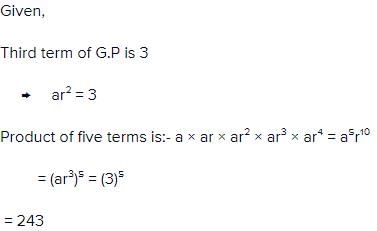
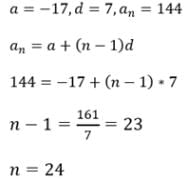
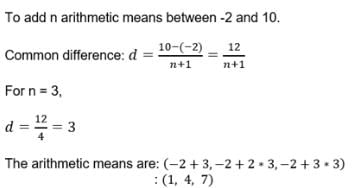

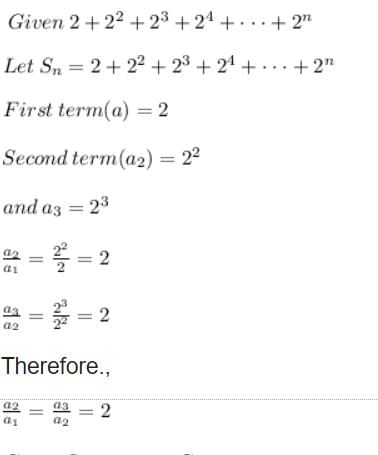 Therefore
Therefore